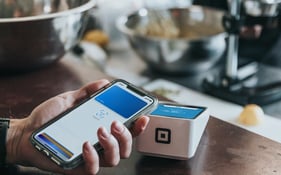At a Glance:
Hiring apps as a quick-fix staffing solution: Many restaurant operators remain understaffed and are turning to on-demand hiring apps as a result. These apps are helping some operators fill available shifts in as little as 24 hours.
Weighing the cost: Most on-demand hiring apps charge a fee per shift filled. To fill shifts quickly and consistently, restaurant operators also generally must offer a higher hourly rate than the market average.
Works best for select roles: On-demand hiring apps work best to fill lower-level positions, like dishwashers, runners, barbacks, and line cooks.
A new way to interview: Some operators are using on-demand hiring apps as a way to test out employees before extending a full-time offer.
For years, Christopher Grossman, executive chef and operating partner of The Chastain, struggled to keep his dishwasher position filled. But a few months ago, that changed after Grossman started using Qwick, an on-demand hiring app that connects F&B professionals with restaurants.
“I never thought I’d be using a temp service, but staffing has never been as hard as it’s been,” says Grossman, who’s used the app to fill 85 dishwashing shifts so far. “Now, if someone calls out, I can fill the shift within a few hours. Every shift I’ve posted [to the app] has been picked up, and I can only count two or three no-shows.”
Qwick is just one among many on-demand hiring apps increasingly being embraced by restaurants in order to fill scheduling gaps. Although the restaurant sector has continued to add jobs across the past year, many operators say they’re still understaffed.
“It just makes life easier – you don’t have to go through interviews and then have people not always workout,” says Tyler Haake, executive chef of Argosy, who’s used Gigpro to fill a wide range of back of house positions. “The tradeoff is that we’re bringing in people we haven’t worked with before and paying more per hour.”
Per the National Restaurant Association’s 2023 State of the Restaurant Industry report, 62% of restaurant operators don’t have enough staff to support current demand. As restaurants continue to scramble to fill positions fast enough, on-demand hiring apps are likely to stick around. But they work best only for certain situations and naturally come with a cost. If you’re curious about how to use one as part of your own staffing strategy, we take a look at how the process typically works, along with the primary benefits and potential downsides to weigh at the start.
How do on-demand hiring platforms work?
1. Sign up and post
With most hiring apps, the process begins with signing up and creating a business profile. From there, you can post available shifts immediately. Generally, there are fields within the post that let you provide a description of required skill sets, an hourly rate, expected shift length, and any other necessary details, like a dress code.
2. Choosing an applicant
Once a post goes live, people can apply. Some apps, like Poached and Gigpro, provide you with a pool of applicants, and you’ll make the final choice. Others, like Qwick, use an algorithm to match you with a temp worker who they arrange to be sent directly to your restaurant.
3. What to expect
All temp workers typically go through a vetting process that includes an online skills test and a follow-up phone interview. With most apps, you can also look through candidates’ profiles to view their experience and read reviews. “For the most part everyone’s been pretty reliable,” says Grossman. “The more we’ve done it, the more we get repeat workers, and if they’re doing a good job, we’ll ask them about their situation and see if they’re interested in anything more permanent.”
4. Insurance
Most apps carry a third-party liability insurance policy that would cover your business from an employee-related incident, like if a temp worker breaks an expensive piece of equipment or pours hot water on someone. Be sure to ask the hiring platform about their insurance policy before signing up.
How much does it cost to use an on-demand hiring app?
Temp workers are hired as independent contractors, and payment is typically processed and received through the app. As a restaurant, you’ll pay the hiring company, and the hiring company pays out the temp worker, typically within 24 hours of when a shift is completed.
Most hiring companies allow you to post shifts for free, and then charge a fee per shift filled. Fee structures vary, but to get an idea, Gigpro charges roughly 20% of the total payment charged per shift. Qwick charges 40% of the total payment payment charged per shift. And Poached charges $39 per shift completed.
Operators set the hourly rate for temp workers, and generally you’ll need to go above market average to find consistent success. “We typically see restaurants pay about a 20% increase over the normal rate,” says Kirk Thornby, founder and CEO of hiring platform Poached. “If you need someone on a Friday night and it’s Friday morning, we guide our employers to offer a premium wage to give motivation.”
How quickly are shifts typically filled?
In major markets, most hiring apps average shift pick-up rates of 24 hours or less.
“In some of our newer markets it might take a little longer, but in our core markets, we’re filling shifts in less than 30 minutes, on average,” says Thornby. “That being said, if there’s not enough incentive on behalf of the operator, you might see some no-fills for last minute shifts.
Potential benefits vs. potential downsides
Pros:
Flexibility to staff your operation as you need it in the moment, including for last-minute call-outs
A convenient way to staff up for major events (i.e. Super Bowl, Valentine’s Day, etc.) or ramp up for seasonal shifts
A creative recruitment strategy and way to reduce interview no-shows
An opportunity to trial candidates before committing the time and money required to onboard employees
Cons:
Only available in select markets: Not typically a solution for restaurants who aren’t located in major cities
Only useful for select positions: On-demand hiring apps work best to fill lower-level positions, like dishwashers, runners, barbacks, and line cooks. For catering and banquets, server and bartender shifts are also popular.
More costly per-hour rates: “As you approach $20-plus per hour, restaurants get a lot more interest [from temp workers],” says Samuel Mylrea, co-founder and CEO of Gigpro. “As you get down to $15 an hour, which is our hourly minimum that you can post, the supply is lower.”
Subjects workers to less protection and potential discrimination: “Once you're an independent contractor, you’re not subject to labor protections that are under the Fair Labor Standard Act, and that puts them at risk of wage theft,” says Anthony Advincula, communications director of Restaurant Opportunities Centers United. “Another shortfall would be increasing gender- and race-based discrimination based on the worker’s profile pictures or names in the app.”
You don’t get to meet candidates before putting them to work: “I’ve had some people that’ve come in that are a little rough around the edges, and I know some managers struggle with those kinds of personalities,” says Haake.





